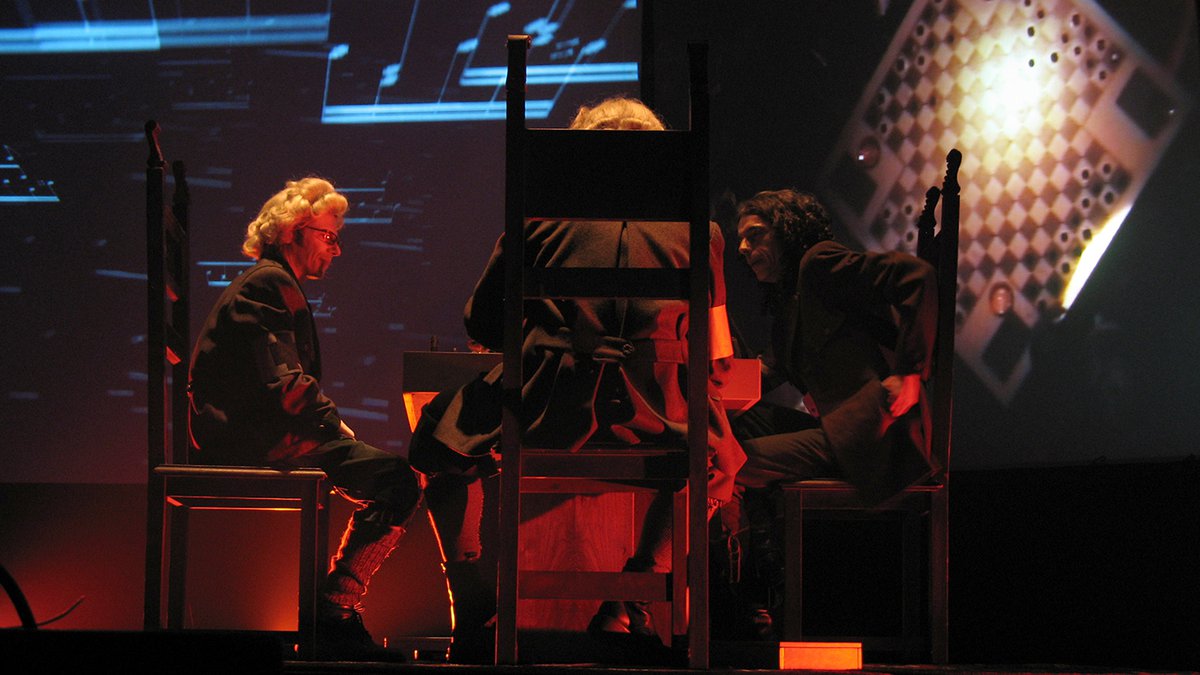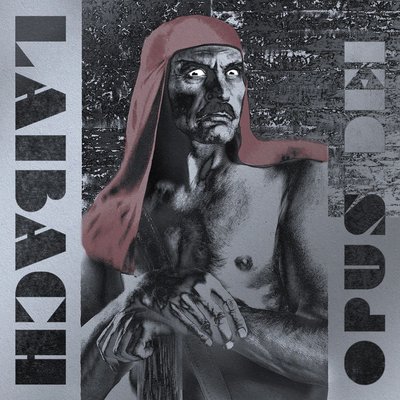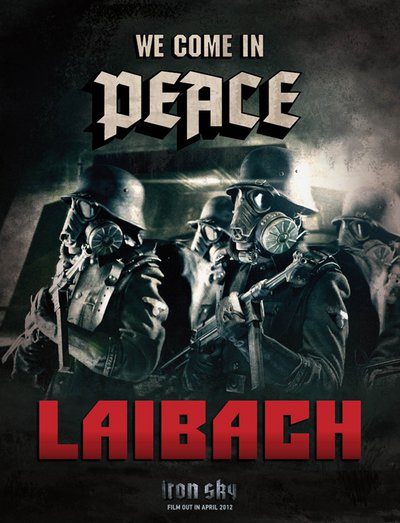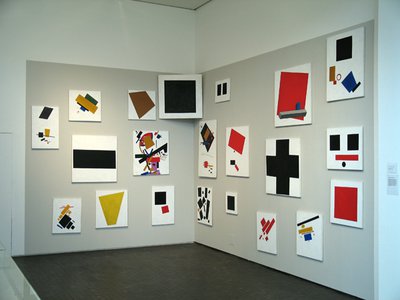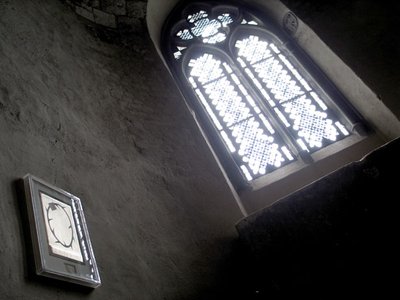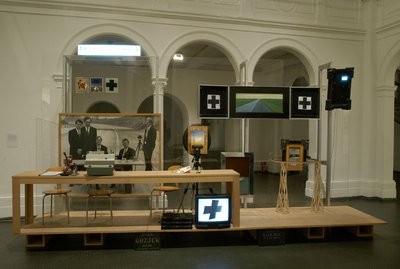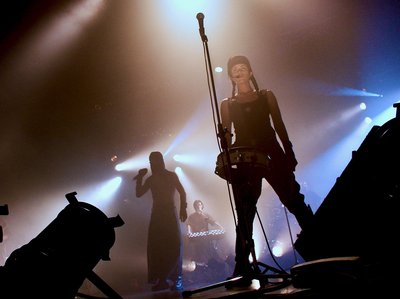Celebrating 321 years of Johann Sebastian Bach and (precisely to the day) 26 years of their own existence, LAIBACH staged their adaptation of Bach's "Die Kunst der Fuge" in Leipzig's "Werk II" on the background of Bach´s native town's annual "Bachfest" on 01.06.2006.
by Hanno Reichel
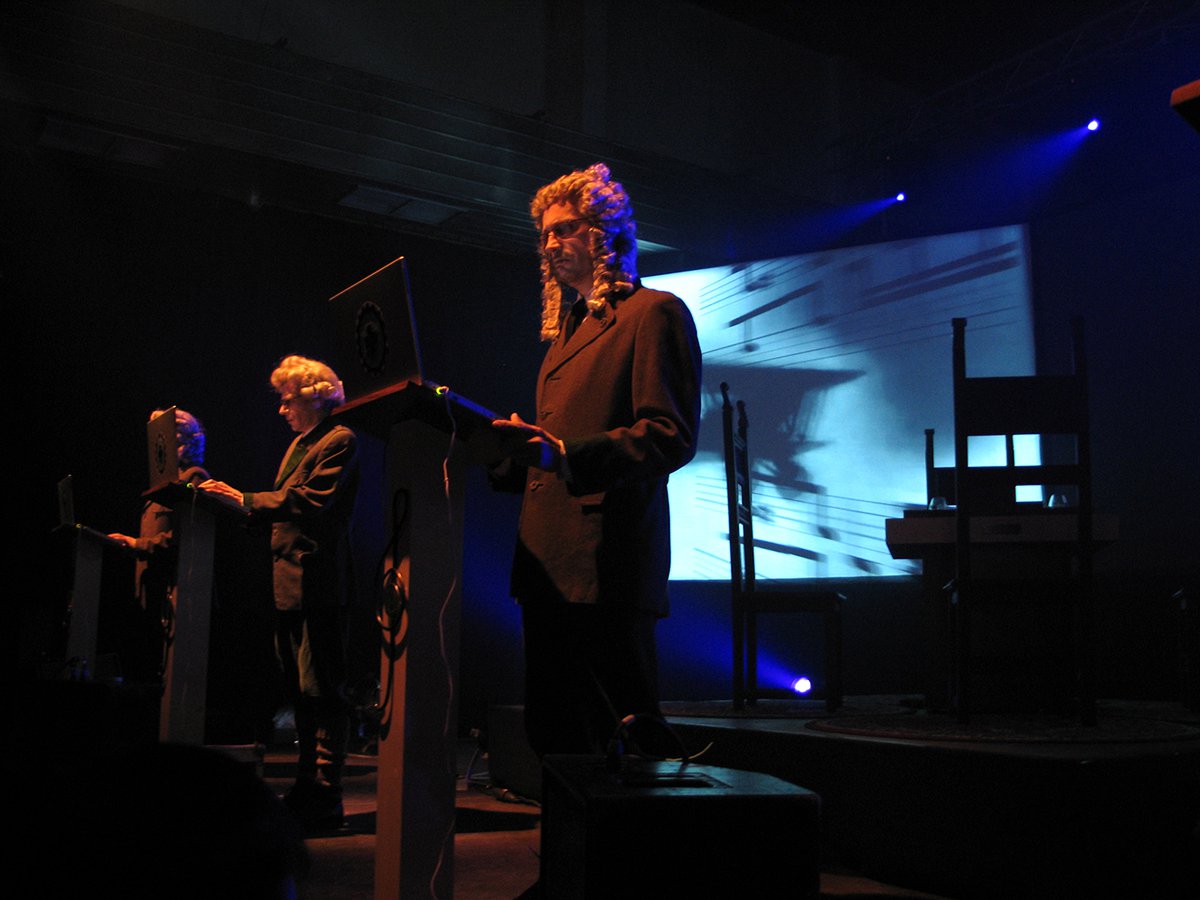
 Concert LAIBACHKUNSTDERFUGE (Leipzig, 2006)
Concert LAIBACHKUNSTDERFUGE (Leipzig, 2006)
I. B-A-C-H
For the last 25 years, the production of cover-versions (or "copies without originals"/"new originals" – LAIBACH), has become a standard element of LAIBACHKUNST and NSK. Nevertheless, due to the fact that in this case we are not dealing with just a certain pop-song or a single piece of visual art taken out of its original context, but with one of the most controversial classical masterpieces of its time and the full adaptation of that whole piece by LAIBACH: What might be the underlying meaning and hidden reverse of the "Fuge" in a LAIBACH-context?
Dating back to the time-period of 1737 to 1750, the original "Kunst der Fuge" is today seen as Bach´s musical opus ultimum and most genius example for the musical compositions of German baroque. Besides that, the piece holds a lot of details that –since its first publication- inspired lots of contradictory interpretations, speculations and mystifications. Speaking of the music itself, "Kunst der Fuge" seems to be most of all a strictly theoretical and technical piece. Up to now, it is not even clear whether Bach had ever intended it to be performed, or if it was created as a purely conceptual and tutorial piece which was not be played, but to be read ("Augenmusik"). In general, the piece develops on the basis of an underlying standard theme ("Contrapunctus 1") and the follow-up of most different parts that apprehend this theme again and again in partly most complex ways of cross-changing, reflecting and rescaling the original pattern. The fact that due to that musical structure, lots of different numbers/codes could be read out of the written piece in a mathematical/cryptographic way and parts of it could be played either in the way they were written or as well vice-versa without changing the melodic flow has up to now been the source of thousands of conspiracy-theories. Those were additionally strengthened by certain suppositions that see Bach as a possible freemason/illuminati and the fact that he died before the "Fuge" was finished, leaving the piece open-ended and thus free to visionary speculations about its complete meaning and sense. The most irritating of these coded references in the "Fuge" is definitely the fact that parts of the underlying theme are based on the tone-sequence B-A-C-H, thus implementing an invisible, immanent, incorruptible and timeless signature of the composer within his piece of art.
Maybe LAIBACH´s actual approach to the "Fuge" is to be seen as an ode to Bach´s ingenious constructive and contextualizing ability: not only to create a piece of art that (behind its visible façade) contents a hidden reverse, but to construct a piece of art that ultimately consists of nothing else but its underlying references and is held together exclusively by its own hidden reverse only. Needless to say that the basic principle of the "Fuge" (variety only as the result of reprising and recontextualizing from a certain basic origin) is in strict accordance with LAIBACH´s self-restriction to their basic concept in their 10 items of the covenant. Another hint for a slight "Seelenverwandschaft" between LAIBACH and Bach concerning the "Fuge" might be found in Bach´s strict and theoretical approach to complex contrapunctual compositions (reaching its final level of perfectionism in the "Fuge"): This approach was, soon after Bach´s death already and later, especially in German totalitarism between 1933 and 1945, hailed as a form of authoritarian art and even mythologized as a national art-symbol for "German order". Thus, LAIBACH´s occupation with Bach isn’t that far away from their occupation with i.e. the eastern avantgardists, concerning the corruption of their artworks by certain systems and ideologies.
II. Kraft-B-A-C-H
The doors of „Werk II" opened at 20:00h, and the venue turned out to be an abandoned factory hall which is now used as a concert venue but still holding its industrial atmosphere with its brick-walls, steel columns and even the former machine-crane still in place on its tracks below the ceilings high above the audience. Speaking of the audience, the occasion of the "Bachfest" and the forthcoming "Wave-Gotik-Treffen" in Leipzig had brought together a bunch of most different people for the concert in "Werk II", from the obligatory LAIBACH-fans over gothics/dark-wavers to dressed-up classic-fans who had occasionally come to Leipzig for the "Bachfest".
The concert started at around 20:45h, revealing already with its first introductory sounds and the stage-setting that besides J.S. Bach, LAIBACH would use the opportunity to pay tribute also to another one of their greatest influences: Kraftwerk. To the beginning techno/electro sounds of LAIBACH´s adaptation of the "Fuge", vier Personen entered the stage one by one and put up behind four minimalist consoles of laptops each bearing a clef and LAIBACH-symbol. The backdrop of the stage featured three large screens and the whole centre part of stage was occupied by a massive white table bearing the Kreuzschach-board and four old-fashioned wooden chairs. LAIBACH were uniformed in kinds of their traditionalist alpinist/hunter’s costumes with breeches, LAIBACH-armbands and baroquian wigs making them ironically resemble the pictures of J.S. Bach and his contemporaries.
The first approximately 15 minutes of the concert occurred quite kraftwerkian with smooth minimalist instrumental techno-/electro-sounds and LAIBACH acting stoically and totally unmoving behind their consoles. A timeless synthesis of the bachian/contrapunctual order of the late 16th century with the later German stereotypes staged by Kraftwerk during the last days of the millennium?
III. Lai-B-A-C-H
After this first introductory part, the group left the consoles and took place leisurely around the table which –by the way- bore on its four sides the inscriptions for the cryptic names EBER-SALIGER-KELLER-DACHAUER, paying tribute to the ancient and mystifying times from the beginning of LAIBACHKUNST. Contrasting their serious and totally emotionless appearance before, the four Schauspieler here acted with obvious sponginess, hanging around the table, drinking, talking, laughing, smoking and last but not least playing the cryptic game of Kreuzschach. The top of the table was transmitted live from a camcorder mounted high above the table to the centre screen on the backdrop so that the audience could follow every single move of the ongoing match which lasted for about one hour to the continuing ambient and industrial sounds of the electronic "Fuge". Amplifying the musical impression, the remaining two displays on the left and right showed videoart-clips with partly typical LAIBACHian aesthetic (Malevich-crosses, NSK-passports, engines, flames, etc.) and other material (general symbolism of transport, energy, music, nature, etc.). The music itself remained a mixture of partly melodic, partly abstract electronic sound structures with intense basses and sometimes aggressive heights. Besides some seconds of a computerized distorted voice repeating the word "LAI---BACH" for a few seconds (most probably as a more open reference to the underlying B-A-C-H-sequence as a reference to the author/composer in the original "Fuge") the whole concert featured no lyrics at all.
The reaction of the audience to the resulting impression was of two kinds: While most of the audience seemed to comprehend what was going on not as a concert in the classic sense, but more as some kind of modern art installation, some others took it as a massive transgression having paid for what was supposed to be a live-concert and now witnessing some decadent artists hanging lazily around a table to the sounds of dance-music from tape. Some attending punks were displeased enough to use some seconds of only very low sound to scan the typical "LAI-BACH! LAI-BACH!"- and "Gebt mir ein Leitbild!"-choirs and caused at least a small reaction of Dejan Knez, looking up irritated from his place at the table to the audience, standing up for a few seconds and then shyly smiling and waving towards that shouting group as if to say "Yes, this is LAIBACH. We are here. Don’t panic."…
The last approximately 15 minutes of the "concert" saw the return of the group to the consoles after having finished their Kreuzschach-match and once again performing at the edge of stage in a kraftwerkian way. With the final sounds fading out, LAIBACH were dismissed by the audience with warm applause even though it could be felt that large parts of the audience were at least puzzled and not absolutely sure about what they had seen and heard.
IV. B-etr-A-C-H-tungen (=considerations)
Speaking of what DIEKUNSTDERFUGE could mean in a LAIBACH/NSK-context, the possibilities of interpretations and views are –due to the already unending amount of myths and philosophical aspects linked to the original "Fuge" itself- indefinite. In fact, there are slight parallels between contemporary views on the original "Fuge" and the actual reception of LAIBACHKUNST: In the same way, in which –among others- Adorno praised Bach as more than just an avantgardist but as an eternally unattainable genius standing outside of any time-related interpretation, LAIBACH follow the concept of not being dependant on time, but being time themselves ("WAT") and thus remain zeitlos while everything else is tot ("Das Spiel ist aus"). Moreover, today´s critics see the "Fuge" as a stylistically most ambivalent piece, uniting the avantgardistic theoretical approach of the structure itself with Bach´s stile antico which was already in its time absolutely out of date and considered "anachronistic" or even "barbarian". And isn’t that the very same ambivalence as in LAIBACH´s monumental retro-avantgarde?
Thus, have these one and a half hours of DIEKUNSTDERFUGE been nothing more than a bow of LAIBACH to their predecessors and influences J.S. Bach and Kraftwerk? Maybe the answer to that question can be found more in the stage-performance and its relation to the "Fuge" than only in the music itself. So, what could be heard and seen on stage on the symbolic level?
The audience witnessed four Schauspieler who, hanging around leisurely and relaxed around a table, gave themselves the impression of acting on the Kreuzschach, making decisions, considering tactics, planning moves, shifting figures and discussing their efforts. So, weren’t these Schauspieler acting symbolically as actual leaders trying to demonstrate their role as the controllers of their dominion? And couldn’t the audience witness the obvious ridiculousness of these efforts with the alleged permanent activity on the Kreuzschach while the real life happens left and right from this group of leaders (symbolized by the material shown on the displays, i.e. references to the fields of war, culture, energy and nature)? And wasn’t it symptomatic that all this screened reality took place out of view of the Schauspieler? And doesn’t this permanent historical Schauspiel of pseudo-important decisions, strategies (and ideologies?) that creates a lot of background noise but never has any of the desired influences on reality equal the structure of the original "Fuge" again, with its endless variations of the same basis? If that is the case, the audience once again played its role as the nation/mob perfectly as desired by LAIBACH: The majority of people was either overwhelmed by the staging and did thus not question the content or was incapable of understanding what went on anyway. A small group of rebellious outcasts (the a.m. group of punks) dared to voice their discontent –most probably without any real understanding as well- and gained the usual reaction: The "leaders" gave a benevolent but arrogant wave and the security threw them out.
In short: Is LAIBACHKUNSTDERFUGE a simile showing a) the impotence of past and present systems and leaders to forge the present (not to speak of the future) in a post-political world and b) the fact that the masses are either unwilling or incapable to change this situation?
We are of God: he that knoweth God heareth us; he that is not of God heareth not us.
(LAIBACH – "Jesus Christ Superstars", 1996)
Considering everything that could be brought forward against him, that Cantor from Leipzig is an appearance of God: clear, but inexplicable.
( Karl Friedrich ZELTER about J.S. Bach in a letter to J.W. GOETHE, 1827)
